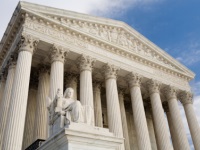
Back on October 8, 2013, we highlighted three cases currently pending on the United States Supreme Court docket that employers will definitely want to follow. The cases address issues ranging from the proper interpretation of Sarbanes Oxley’s whistleblower provision to the breadth of Presidential NLRB appointment power, to what constitutes “changing clothes” under the FLSA. Although decisions have not yet come down, important developments have taken place in all three cases.
#1 : Lawson v. FMR LLC (Fidelity Investments)
The question before the Supreme Court in Lawson v. FMR LLC is whether an employee of a private contractor or subcontractor hired by a public company is protected from retaliation by the Sarbanes Oxley Act’s (“SOX”) whistleblower provision. Petitioners argue that Section 1514A of SOX protects employees of public companies and their contractors (whether private or publicly held) from retaliation for engaging in a protected activity. Respondents argue that Section 1514A does not protect the employees of private contractors retained by a public company. The Supreme Court heard argument on November 12, 2013.
Oral argument focused on concerns over the scope of the SOX protection: Petitioners’ interpretation of SOX coverage could theoretically reach the domestic employees of officers of a public company—an interpretation that raised concerns with some Justices. Several Justices also raised questions as to the extent to which one-time contractors are protected by Section 1514A, and whether all types of fraud or just fraud related to the work performed by the contractor or subcontractor would be covered by SOX. The Justices pushed Petitioner, Respondent and amici curiae United States to define the limitations of their proposed statutory interpretations, and indicated that their opinion will have to articulate a rule that addresses the limitations of Section 1514A.
Note: Orrick prepared the amicus brief filed by the Securities Industry and Financial Markets Association (SIFMA) in Lawson. To obtain a copy of that brief, or other briefs in the case, contact Mike Delikat.
#2: National Labor Relations Board v. Noel Canning
NLRB v. Noel Canning addresses whether the President’s recess-appointment power (i) may be exercised during a recess within a Senate session or is limited to recesses that occur between Senate sessions; (ii) may be used to fill vacancies that exist during a recess or is limited to vacancies that first arose during that recess; and (iii) may be exercised when the Senate is convening in pro forma sessions.
On December 9, 2013, the Court granted Senate Republican Leader Mitch McConnell’s (and 44 other members of the United States Senate) motion for leave to participate in oral argument as amici curiae in support of Respondent Noel Canning and for divided argument. In granting the motion, the Court expanded the time for oral argument from one-hour to ninety minutes: forty-five minutes for Petitioner NLRB; thirty minutes for Respondent Noel Canning; and fifteen minutes for amici curiae Senate Republican Leader Mitch McConnell. Argument is set for Monday, January 13, 2014.
#3: Sandifer v. United States Steel Corp.
Under Section 203(o) of the Fair Labor Standards Act (“FLSA”), an employer need not compensate employees for time spent “changing clothes” if (i) that time is excluded from working time by express terms of a collective bargaining agreement or (ii) by custom or practice under a collective bargaining agreement. U.S. Steel Corporation workers (Petitioners) argue that the steel workers’ “protective gear” is not “clothing” within the meaning of Section 203(o), so employees must be compensated for time spent donning and doffing this gear. The Supreme Court heard argument on this issue on November 4, 2013.
Oral argument centered around Petitioner’s, Respondent’s and the amici curiae United States’ proposed definitions of clothing. Petitioner advocated for a rule that items designed and worn to protect the wearer against workplace hazards should not be considered “clothes” within the meaning of Section 203(o). A few Justices noted that all clothing has a protective function of some sort, and had difficulty distinguishing workplace hazards from ordinary protection against the “vicissitudes of life.” Respondent U.S. Steel Corp. advocated for a rule that “changing clothes” should include the entire process of donning and doffing a work outfit (including eye gear, hard hats, glasses, ear plugs, etc.). The Justices seemed equally skeptical of this broad rule, and pointed out that such a broad rule is unnecessary where it appears that all of the steel workers’ items fit within the ordinary definition of “clothes.” Amici curiae United States argued that “clothes” should have its ordinary meaning, and therefore should be distinguished from “equipment,” but that regardless, all of the items the steel workers donned fell within the ordinary meaning of “clothes.”

